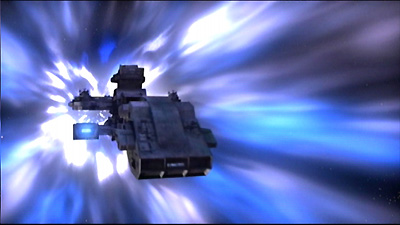HYPERSPACE

Hyperspace, also referred to as hyperdrive, is the capability of ships to travel faster than the speed of light, making interstellar travel possible. Ships capable of hyperspace travel are powered by sub-light engines for travel below the speed of light. To achieve light speed, the ship is enveloped within a hyperspace field, taking it out of the normal space dimension. Hyperdrive engines use a crystal power source to provide the enormous amount of energy required to generate a hyperspace window. It is normally the case that once a vessel has entered hyperspace, its location cannot be traced, and its weapons and shields cannot be engaged.
The motherships of the Asgard and the Goa'uld are capable of faster-than-light travel, as are certain smaller ships such as the Goa'uld alkesh, and the cargo ship, or teltac, however the death glider is not capable of entering hyperspace because it is too small to carry the Goa'uld version of the hyperspace window generator.
The SGC had developed naquadria-powered hyperdrive engines for use on the X-302 and the Prometheus, however these remained experimental and were functional only for short bursts of energy because of the instability of the naquadria. During an early mission of the Prometheus, the unstable naquadria caused a power surge, and the reactor module went critical and had to be jettisoned, leaving the ship stranded near Tagrea. Afterward, Prometheus acquired a more reliable power source when the Asgard installed new hyperdrive engines on Earth's most powerful ship, making it capable of intergalactic travel.
Subsequent ships, including the Odyssey, have also been equipped with the more stable Asgard hyperdrive engines, making travel possible to Atlantis in the Pegasus Galaxy or Orilla in the galaxy of the Asgard. During the mission to Orilla, however, an Asgard computer core was installed aboard the Odyssey which was fully integrated into all the ship's functions, including the hyperdrive. Inexplicably, the Asgard upgrades seemed to allow Ori warships to trace the Odyssey through hyperspace, perhaps due to a unique energy signature being emitted from the new power source that was detectable from subspace. To prevent the ship from being tracked in hyperspace, the new Asgard core had to be isolated from the hyperdrive controls.
In several instances, SG-1 has used hyperspace technology in unique situations that have not required faster-than-light travel. When Earth faced annihilation by an asteroid, SG-1 prevented the collision by expanding the hyperspace field of the cargo ship to encompass the entire asteroid, taking it out of normal space long enough to pass through the Earth and reappear on the other side. Similarly, a short controlled burst of the hyperdrive engines on the F-302 allowed O'Neill and Carter to enter subspace long enough to penetrate the shields of Anubis's mothership in the battle to destroy his superweapon. Carter also succeeded in extracting the Prometheus from the gas nebula in which it was trapped by creating a partial shift into hyperspace, essentially taking the ship out of the cloud's space-time long enough to eliminate its corrosive effects on the sub-light engines, allowing them to engage and to draw the ship from the cloud.
Cross Reference: Alkesh, Asgard, Asgard Mothership, Asteroid, Crystals, Daedalus, F-302, Ha'tak, Naquadria, Nebula, Odyssey, Prometheus, Teltac, X-302
First Introduced: Within the Serpent's Grasp
Significant Episode Reference: Fail Safe, Memento, Fallen, Grace, Unending
